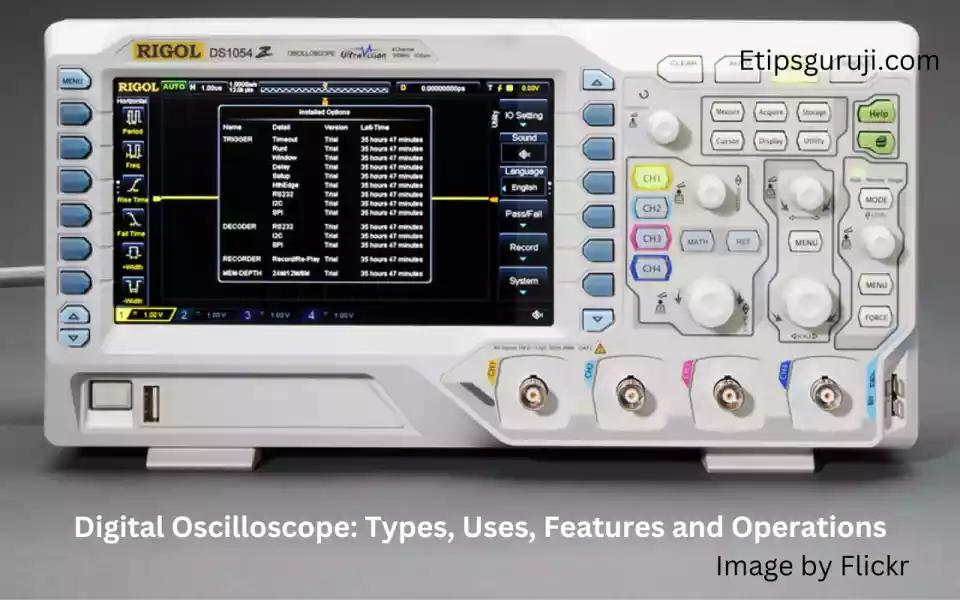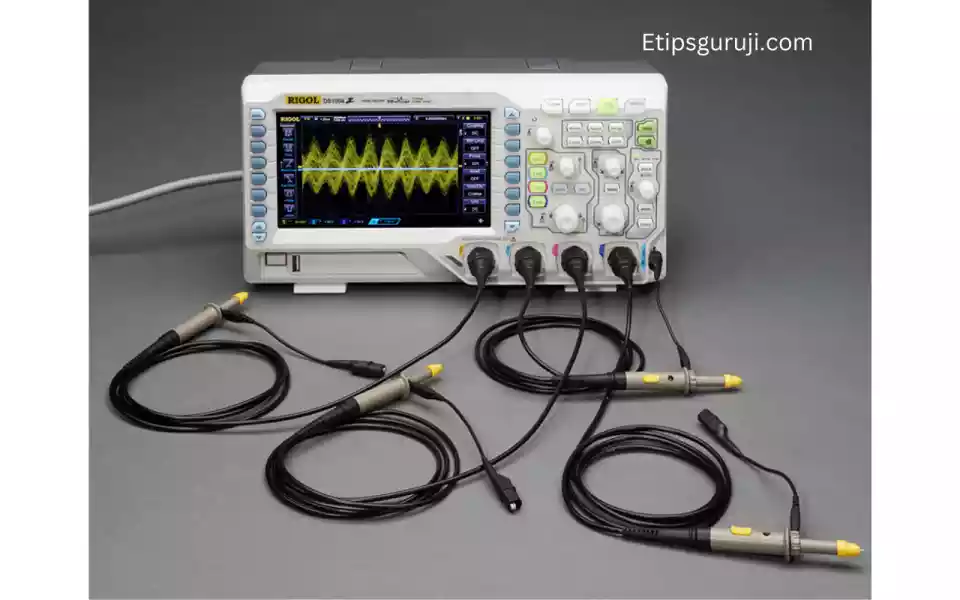Digital Oscilloscope: Types, Uses, Features and Operations

A digital oscilloscope is an indispensable instrument in the realm of modern electronics. It plays a important role in the design, manufacturing, and repair of electronic devices.
By transforming electrical signals into visual representations, these versatile tools empower users to swiftly and accurately analyze and measure properties such as:
- Amplitude
- Frequency
- Waveform shape
Rapid Technological Advancements: Evolving Oscilloscopes
Owing to fast-paced advancements in technology, oscilloscopes have evolved into highly efficient devices with diverse form factors, bandwidths, and sampling rates. For example:
- Handheld oscilloscopes
- Modular oscilloscopes
- USB oscilloscopes
These portable options have revolutionized the industry. Notably, leading companies like Keysight and Tektronix have developed digital oscilloscopes with impressive specifications of bandwidth up to 1 GHz and sampling rate up to 2.5 GS/s
Types of Oscilloscopes
Analog Oscilloscopes
Analog oscilloscopes are instruments that capture and display voltage waveforms in real-time. They are invaluable tools for analyzing time-varying electrical signals. Though they have been mostly replaced by digital oscilloscopes, analog oscilloscopes still hold their own for several reasons:
- Handling transient signals: They can capture transient details that digital oscilloscopes might miss.
- Fast response time: This makes them particularly useful in various troubleshooting applications.
- High sensitivity: Their ability to detect small changes in signals is still appreciated by many professionals.
Digital Oscilloscopes
With the recent digital trend, digital oscilloscopes pushed boundaries of what an engineers and technician can do with their advanced features and versatility. Some benefits of using digital oscilloscope over analog are:
- Higher resolution: This allows for more accurate and precise measurements.
- Storage capabilities: Users can save waveforms for later analysis or comparison.
- Enhanced measurement options: Digital oscilloscopes offer a wide array of measurement tools and features.
There are several types of digital oscilloscopes, each designed to cater to specific requirements, making them a popular choice in modern electronics work. Some of them listed below
- Digital Storage Oscilloscopes (DSOs): They are the most common and can capture, store, and analyze signals in a digital format, which makes it easy to:
- Save measurements
- Compare data
- Digital Phosphor Oscilloscopes (DPOs): DPOs display waveforms similar to analog phosphor oscilloscopes, offering improved visibility and resolution for transient signals. High-end DPOs provide capabilities comparable to those of analog oscilloscopes.
- Mixed Signal Oscilloscopes (MSOs): They are designed to work with both analog and digital signals with combine the functionality of:
- A digital storage oscilloscope
- A digital logic analyzer
- This dual functionality makes MSOs an indispensable tool in various electronics applications.
- Digital Sampling Oscilloscopes: These oscilloscopes are used for very high-speed signal analysis, as they can capture waveform points at variable intervals. They’re ideal for situations where a high bandwidth is required.
Digital Oscilloscope Features

Digital oscilloscopes provide various features that make them essential tools for measuring and analyzing electrical signals.
A. Bandwidth
The bandwidth of an oscilloscope determines the highest frequency it can measure without significant signal distortion.
It is essential to choose an oscilloscope with a bandwidth that can accommodate the frequency components of the signals being measured.
Generally, oscilloscopes with higher bandwidths are more versatile and able to analyze a broader range of signals.
B. Sampling Rate
The sampling rate of a digital oscilloscope describes the number of sample points it can process per second.
A higher sampling rate allows the oscilloscope to capture more details. According to the Nyquist theorem, an oscilloscope should have a sampling rate of at least twice the highest frequency component of the signal to provide an accurate representation.
C. Memory Depth
Memory depth refers to the amount of data a device can store and analyze at any given time.
The digital storage oscilloscope (DSO) is an example of an oscilloscope that relies on memory depth to store and process signals.
A greater memory depth allows users to capture longer-duration signals or to view more detailed information at a given time scale, making it easier to analyze complex or rapidly changing signals.
D. Resolution
Resolution is a crucial feature of a digital oscilloscope, as it determines the smallest voltage change that can be detected and displayed.
Higher resolution oscilloscopes can differentiate between smaller voltage changes, resulting in more accurate signal analysis.
The resolution of a digital oscilloscope is typically expressed in bits, with common values ranging from 8 to 16 bits or even higher, depending on the application and oscilloscope model.
Read More: Photometers: Types, Filters, and Applications.
Basic Functions and Operations

Digital oscilloscopes are essential for engineers and technicians to observe and analyze electronic signals. In this section, we’ll explore basic functions and operations of digital oscilloscopes, such as triggering, waveform measurements, and data acquisition.
A. Triggering
Triggering is a critical function in digital oscilloscopes, allowing users to stabilize and examine repetitive waveforms. The trigger system is one of the three main systems in a basic oscilloscope, along with the vertical and horizontal systems.
It is responsible for accurately reconstructing a signal by synchronizing the display with particular points in the waveform.
The trigger system typically allows users to choose between various types of triggers, such as:
- Edge triggering
- Pulse triggering
- Video triggering
- Logic triggering
B. Waveform Measurements
Waveform measurements are an important aspect of digital oscilloscopes, as they provide engineers with the ability to analyze several parameters of a signal.
Modern oscilloscopes offer fully-automated measurements that can be selected through front-panel buttons or screen-based menus. These measurements include:
- Amplitude
- Period
- Rise/fall time
- And many more
C. Data Acquisition
The process of data acquisition in digital oscilloscopes involves sampling and storing the electronic signals for further analysis.
According to an oscilloscope fundamentals primer, there are two main functions: acquisition and analysis. During acquisition, the sampled signals are saved in memory, while in the analysis phase, the stored waveforms are analyzed and displayed on the oscilloscope screen.
Digital oscilloscopes come in various types, each with distinct specifications and features to accommodate different user requirements.
These instruments have evolved significantly over the years, with modern oscilloscopes offering numerous additional functions to aid electronic engineers and technicians in their measurements and analysis tasks.
Advanced Applications
Key Applications of Digital Oscilloscopes: Serial Data Analysis, Power Analysis, and Segmented Memory
1. Serial Data Analysis
Digital oscilloscopes are increasingly utilized for serial data analysis in modern communication systems. Engineers can leverage built-in protocol decoders to analyze and decode various serial data protocols, such as:
- I2C
- SPI
- UART
These instruments provide triggering capabilities, enabling users to capture specific events and identify potential issues in communication systems.
2. Power Analysis
Power analysis is crucial in designing and optimizing power circuits, such as switch-mode power supplies and motor drives. Digital oscilloscopes can measure voltage and current waveforms to calculate and display real-time power parameters, including:
- Active power
- Reactive power
- Apparent power
These insights allow engineers to understand power utilization, efficiency, and harmonic distortion in their designs.
3. Segmented Memory
Segmented memory is a valuable feature in digital oscilloscopes, offering a more efficient method for capturing and analyzing waveforms.
By dividing the memory into smaller segments, oscilloscopes can capture multiple events with high resolution and time accuracy.
This capability is particularly useful when analyzing rare or intermittent events, as it enables engineers to focus their analysis on relevant waveform data while minimizing memory usage.
Selecting the Right Digital Oscilloscope
When choosing a digital oscilloscope, several factors significantly affect the overall performance and usability of the instrument. Here are the most essential aspects to consider:
1. Bandwidth
The oscilloscope’s bandwidth should be at least five times the maximum frequency of the signals you plan to capture. This ensures accurate measurements by minimizing signal distortion.
2. Sampling Rate
Higher the sampling rate, the more accurate is the readings. To avoid aliasing, a rule of thumb is that the sampling rate should be at least twice the oscilloscope’s bandwidth.
3. Sampling Modes
Some oscilloscopes offer various sampling modes. These modes can help achieve better results in specific measurement applications.
For example, equivalent-time sampling (ETS) may be beneficial in acquiring high-frequency signals with a lower sampling rate oscilloscope. Other factors you need to consider are:
- Memory depth
- Display resolution
- Triggering capabilities
- I/O options and connectivity
- Number of channels
Understanding the requirements of your specific applications will help you choose the most suitable digital oscilloscope.
Always compare different models and brands, like Rohde & Schwarz and Keysight, to ensure the best match for your needs.
Read More:
